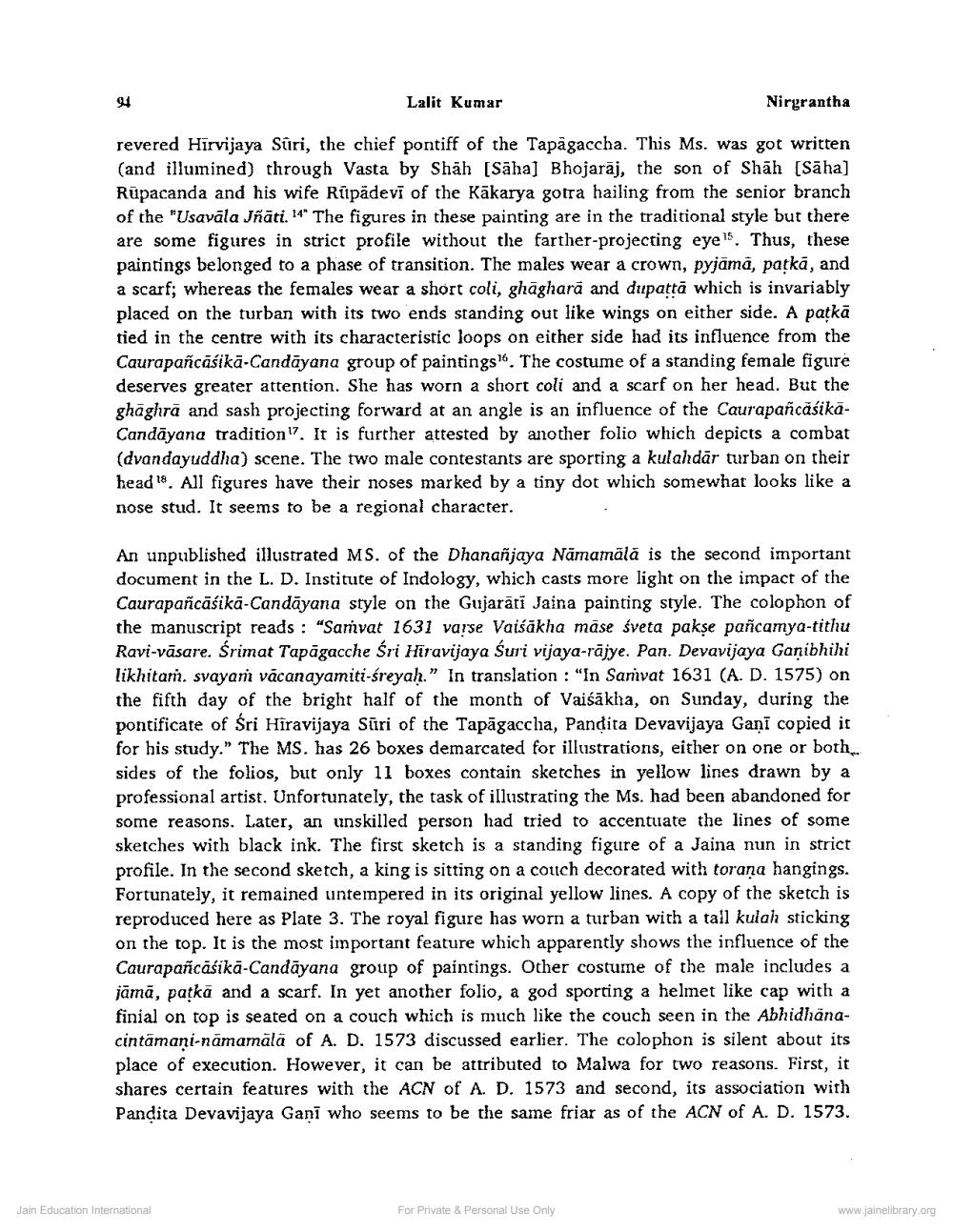Book Title: Gujarati Painting of 16th 17th Century Author(s): Lalit Kumar Publisher: Z_Nirgrantha_1_022701.pdf and Nirgrantha_2_022702.pdf and Nirgrantha_3_022703.pdf View full book textPage 3
________________ بو Lalit Kumar Nirgrantha revered Hirvijaya Suri, the chief pontiff of the Tapagaccha. This Ms. was got written (and illumined) through Vasta by Shāh [Saha) Bhojarāj, the son of Shāh (Sāha) Rūpacanda and his wife Ripädevi of the Kakarya gotra hailing from the senior branch of the "Usavāla Jñāti. 14* The figures in these painting are in the traditional style but there are some figures in strict profile without the farther-projecting eyes. Thus, these paintings belonged to a phase of transition. The males wear a crown, pyjāmā, patkā, and a scarf; whereas the females wear a short coli, ghāgharā and dupatta which is invariably placed on the turban with its two ends standing out like wings on either side. A patkā tied in the centre with its characteristic loops on either side had its influence from the Caurapañcāśikā-Candāyana group of paintings. The costume of a standing female figure deserves greater attention. She has worn a short coli and a scarf on her head. But the ghāghrā and sash projecting forward at an angle is an influence of the CaurapañcāśikaCandāyana tradition. It is further attested by another folio which depicts a combat (dvandayuddha) scene. The two male contestants are sporting a kulahdar turban on their head 18. All figures have their noses marked by a tiny dot which somewhat looks like a nose stud. It seems to be a regional character. An unpublished illustrated MS. of the Dhananjaya Nāmamālā is the second important document in the L. D. Institute of Indology, which casts more light on the impact of the Caurapañcāśika-Candāyana style on the Gujarati Jaina painting style. The colophon of the manuscript reads : "Sanivat 1631 varse Vaišākha māse sveta pakse pañcamya-tithu Ravi-vāsare. Śrimat Tapāgacche Śri Hiravijaya Suri vijaya-rājye. Pan. Devavijaya Ganibhihi likhitam. svayam vācanayamiti-śreyah.” In translation : "In Sanvat 1631 (A.D. 1575) on the fifth day of the bright half of the month of Vaišākha, on Sunday, during the pontificate of Śri Hîravijaya Sūri of the Tapāgacchia, Pandita Devavijaya Gani copied it for his study." The MS. has 26 boxes demarcated for illustrations, either on one or both sides of the folios, but only 11 boxes contain sketches in yellow lines drawn by a professional artist. Unfortunately, the task of illustrating the Ms. had been abandoned for some reasons. Later, an unskilled person had tried to accentuate the lines of some sketches with black ink. The first sketch is a standing figure of a Jaina nun in strict profile. In the second sketch, a king is sitting on a couch decorated with torana hangings. Fortunately, it remained untempered in its original yellow lines. A copy of the sketch is reproduced here as Plate 3. The royal figure has worn a turban with a tall kulah sticking on the top. It is the most important feature which apparently shows the influence of the Caurapañcāśikā-Candāyana group of paintings. Other costume of the male includes a jāmā, patkā and a scarf. In yet another folio, a god sporting a helmet like cap with a finial on top is seated on a couch which is much like the couch seen in the Abhidhanacintamani-namamālā of A. D. 1573 discussed earlier. The colophon is silent about its place of execution. However, it can be attributed to Malwa for two reasons. First, it shares certain features with the ACN of A. D. 1573 and second, its association with Pandita Devavijaya Ganī who seems to be the same friar as of the ACN of A. D. 1573. Jain Education International For Private & Personal Use Only www.jainelibrary.orgPage Navigation
1 2 3 4 5 6 7 8 9 10 11 12 13 14 15 16 17 18
